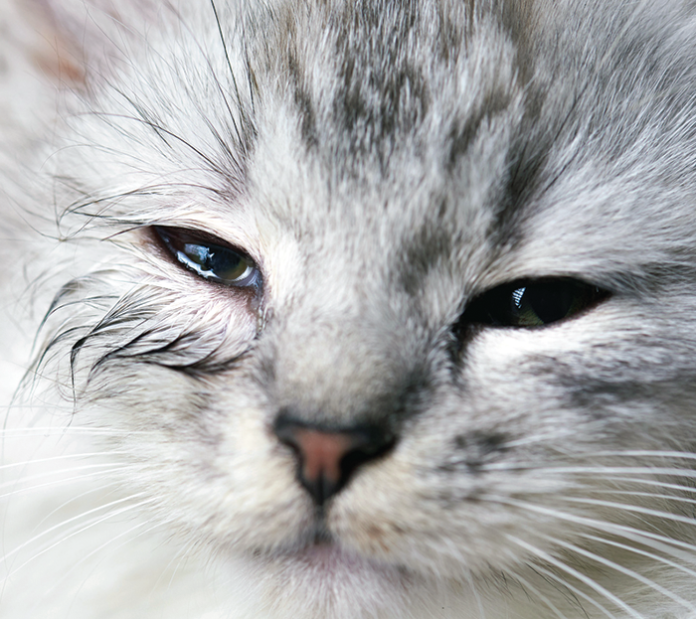Cats can get runny eyes for a variety of reasons—and the cause may not necessarily be in the eye itself.
Your cat may just have something in his eye, but chronic tearing suggests a more involved cause. Thomas J. Kern, DVM, DACVO, Associate Professor of Ophthalmology at Cornell, says that runny eyes in cats are often related to “common upper respiratory infections (URIs), even without respiratory signs—chlamydia, mycoplasma, herpesvirus, calicivirus. Rarely, malformations or malpositioning of the tear drainage ducts may cause excessive watery discharge, especially in brachycephalic (short-faced) cats like Persians, due to overflow of normal tears.”
You may notice clear watery discharge or it could be more like mucous. “Runny eyes from all of these causes may affect one or both eyes simultaneously or sequentially, acutely or chronically,” Dr. Kern says. “Many cats have intermittent crusty discharge, often brown or black, that accumulates at the inside corner of the lids; this seems to be a tear film remnant and can usually be managed by simple removal with a cotton ball or Q-tip as needed.”
Debris and Abrasions
If your cat’s eyes are normally dry and clear, but you notice tearing in one, he may have gotten something in it. Even a small piece of dirt or plant material can cause irritation and discomfort. If he will let you, flush the affected eye with plain artificial tears. The artificial tears may sweep the debris out of the eye.
Unfortunately, even the smallest foreign body can damage the cornea. Scratches are painful and combine with the natural moisture of the eye to provide an ideal environment for infection. These infections can become ulcers that, if left untreated, can gradually chew through the cornea and can rupture the eye.
While this is terrible, the good news is that your veterinarian can easily check for ulcers and abrasions with a fluorescein stain. This stain runs off of healthy cornea tissue but sticks to scratches and ulcers. These areas will look bright green when viewed with a blacklight.
In most cases, ulcers and abrasions can be treated with topical drops and ointments, but if the ulcer is severe or does not respond to treatment, your veterinarian will likely refer you to a veterinary ophthalmologist for more intensive diagnostics and treatment.
Upper Respiratory Infections
Cats are prone to URIs. These infections are all highly contagious and spread quickly between cats. The ocular discharge from a cat with a URI can vary in color and consistency. Some cats just experience a little crusting in the corners of the eyes, while others can have such severe discharge that the eyes are crusted shut. As well as runny eyes, these cats often have nasal discharge and may show lethargy, inappetence, coughing, sneezing, and/or tongue ulcers. Some may have difficulty breathing or only be able to breathe through their mouths.
If your cat is showing respiratory signs, let your veterinary staff know ahead of time. They may have you come in through a different door or use a particular exam room to limit exposure and spread to other patients.
Calicivirus and herpesvirus (viral rhinotracheitis) are included in the typical rhinotracheitis-calicivirus-panleukopenia (RCP) vaccine. This vaccine is recommended for all cats and kittens. The chlamydia vaccine is not recommended for all cats.
Your cat will receive symptomatic treatment to alleviate his symptoms and may start antibiotic therapy if a bacterial agent is suspected. A swab can be sent out to a lab to identify the cause of the infection and determine the best treatment option.
Tear-Duct Abnormalities
Your cat has nasolacrimal ducts in the corner of his eyes that drain into his nasal cavity. These ducts allow the normal tears that keep his corneas moist and healthy to drain out of the eye. If the tear ducts are blocked or not in the correct spot, excess tears will build up and spill over the lower eyelid to track down your cat’s face. Over time, this can cause staining.
Your veterinarian can do a quick check of the nasolacrimal ducts at the same time that he/she is checking for scrapes and ulcers. If the ducts are open and functioning normally, the fluorescein stain will drain into the nasal cavity and a little will come out your cat’s nose. So don’t panic if you see some fluorescent green dripping from his nose—that’s good! If the stain does not appear near the nose, more testing may need to be done to evaluate the tear ducts and identify any potential problems.
The tear ducts can be flushed to clear them. This is a minor procedure, but your cat will likely need to be sedated.
Bottom Line
“I don’t recommend home treatment for undiagnosed eye conditions,” says Dr. Kern. “Some of the causes can progress to painful and/or sight-threatening conditions. And unlike most dogs, cats melodramatically and physically—with claws and teeth—resist application of ocular medications, so it’s worth saving the patient’s ‘kitty minutes’ for treatments that are specifically indicated.” Seeking veterinary care promptly for eye discharge helps ensure you start the right treatment to get your kitty feeling better as soon as possible.
You Should Know
Seek care for eye discharge if:
- The cat also has respiratory signs
- The discharge is purulent (has pus)
- The cat is squinting
- You notice light sensitivity
- The corneas are cloudy or opaque
- Vision is impaired
- Discharge with any of the above




